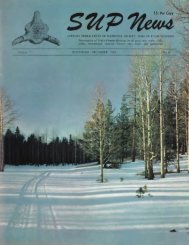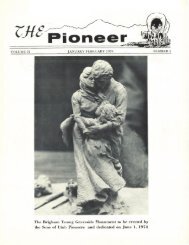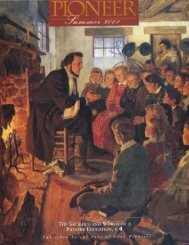Create successful ePaper yourself
Turn your PDF publications into a flip-book with our unique Google optimized e-Paper software.
Egan turned himself in. His case was dismissed<br />
when on October 3 First District Court Justice<br />
Brandenburg abandoned his post and fled back East.<br />
Nonetheless, two weeks later Howard Egan turned<br />
himself in again and was arraigned before Mormon<br />
Justice Zerubbable Snow. Seth M. Blair was the prosecutor<br />
and Mormon Apostle George A. Smith and<br />
William W. Phelps served as the defense attorneys.<br />
This was the first murder trial convened in Utah<br />
Territory. The trial jury on October 18 returned a verdict<br />
of “not guilty.” On March 6, 1852, using the Egan<br />
case as a precedent, the Utah Territorial Legislature<br />
passed the Justifiable Homicide Act. The Act provided<br />
that it would be justifiable homicide for a relative to<br />
kill the person who had defiled a wife.<br />
On September 19, 1852, Captain Egan departed<br />
Great Salt Lake City on mule-back to deliver Pacific<br />
Express Company packages to Sacramento. It took 11<br />
days to traverse the 500 miles. Colonel George W.<br />
Chorpenning, Jr., and Absalom Woodward had established<br />
an overland stagecoach line under an 1851 government<br />
mail contract. The result was that Egan<br />
scouted a Central Overland Route between Great Salt<br />
Lake City and San Francisco. Egan’s route was in contrast<br />
to that of the Oregon Trail to the north and the<br />
Santa Fe Trail to the south.<br />
When Captain James H. Simpson of the U.S. Corps<br />
of Topographical Engineers in 1859 was<br />
ordered to map a road from Camp Floyd to<br />
Genoa at the California border,<br />
he recommended the<br />
route scouted by Captain<br />
Egan. This became<br />
the Overland Trail for the stagecoaches, the Pony<br />
Express, and subsequently the telegraph, the railroad,<br />
and the “Lincoln Highway.” However, Salt Lake City<br />
wanted itself instead of Ely to be the hub where the<br />
fork in the highway divided traffic going to Los<br />
Angeles or to San Francisco. Therefore, Utah subsidized<br />
Highway 40 to go right through the Salt Flats instead<br />
of along the old Pony Express Trail.<br />
In 1855, and for several years thereafter, Howard<br />
Egan was employed by Livingston & Kincaid of Great<br />
Salt Lake City to purchase cattle and drive them to<br />
California. 9 Prior to losing his government mail contract<br />
and before the Pony Express was organized,<br />
Chorpenning hired Egan to superintend his overland<br />
stage mail route between Great Salt Lake City and the<br />
Humboldt River. Egan established his headquarters at<br />
Deep Creek.<br />
In the spring of 1858 General Albert Sidney<br />
Johnston’s troops approached Utah with what at the<br />
time constituted nearly a third of the entire U.S. Army.<br />
Howard Egan was appointed as a major in the Nauvoo<br />
Legion together with Lot Smith to guard the mountain<br />
passes. He left his son, 16-year-old Richard Erastus<br />
“Ras” Egan, in charge of the Egan Salt Lake home. His<br />
instructions were to burn the house if the soldiers occupied<br />
the City. Major Egan served as a bodyguard<br />
for Colonel Thomas L. Kane, who journeyed to<br />
The “Old Sow” cannon<br />
is on display at the<br />
LDS Museum<br />
of Church<br />
History<br />
and Art.<br />
e<br />
<strong>2010</strong> Vol. 57, <strong>No.2</strong> PIONEER 17<br />
◆ ◆







